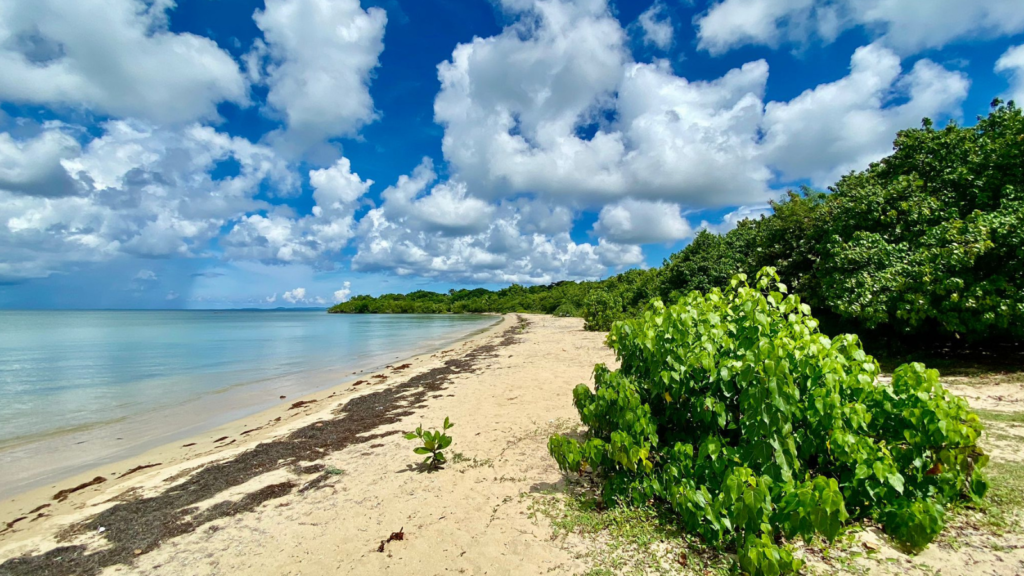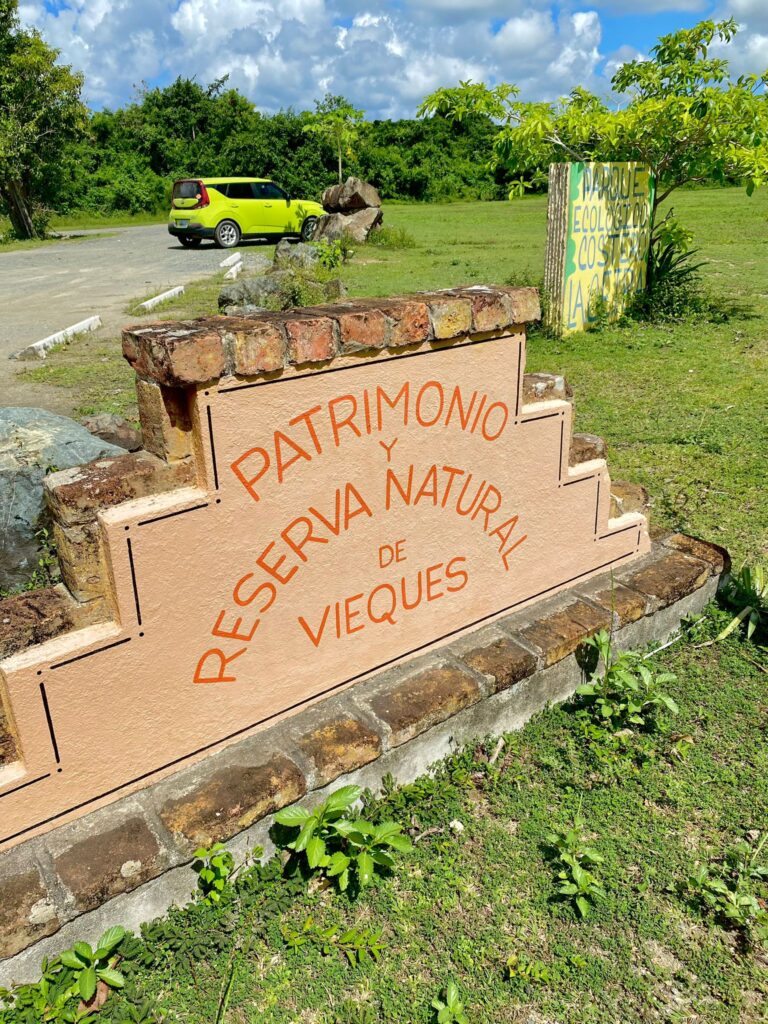In the Mosquito neighbourhood, there is an ancestral giant tree: a colossal ceiba with hundreds of years of history. Its greyish, rough trunk appears as if it was carved by centuries of Caribbean winds, while its branches spread elegantly, covering a wide space with its green and leafy canopy. From the base of the tree, its immensity is astonishing: it rises tens of meters, with roots that spread like tentacles towards the ground, and embrace the earth with force. Its presence is impressive.
In the nearby sea, there breathes an emerald-hued marine prairie that stretches towards the horizon, bordered by mangroves with intertwined roots that seem to plunge into the bowels of the island. Wild horses in shades of brown and white trot gently through the surroundings, their manes waving in the wind; while small birds in vibrant plumage —red, yellow and blue— perch in the branches, filling the air with soft trills. The landscape around the ceiba tree moves in harmony: the breeze brings a murmur from the sea, mingling with the rustle of the leaves.
This tree has witnessed the historical events that have shaped the island of Vieques. It withstood both the Spanish colonial rule and the military occupation by the U.S. Navy, as well as the people’s struggle for peace; and more recently, the vulnerability experienced during Hurricane Maria’s aftermath. Through it all, the ceiba has remained standing.
It was not until 2012 that the municipal government of Vieques declared the area as La Ceiba Park Nature Reserve, which represented a crucial step in the protection and preservation of this natural and cultural treasure. The reserve comprises a diversity of ecosystems, including mangroves, wetlands, estuaries and beaches inhabited by endangered species, such as the West Indian manatee, the brown pelican and the green turtle. This area is home to the most extensive marine prairie in the archipelago of Puerto Rico. The reserve has approximately 51 acres.

However, the land was not always protected for its ecological and cultural value. In the 1930s, the U.S. Navy expropriated these lands to construct its military base, from where they carried out military practices during 60 years of occupation. Very close to La Ceiba, the access gate to the military base was located. Hundreds of soldiers passed through this area every day. Before being displaced by the military, the Mosquito neighbourhood had a vibrant community, with schools and many homes. The ferry, which connects Vieques with Puerto Rico’s main island, used to depart from there.
After the Navy ceased bombing practices, much of the previously occupied territory became a U.S. Wildlife Reserve, under the management and control of the U.S. Fish and Wildlife Service. However, La Ceiba Park Nature Reserve is managed by the community. This act of conservation is more than just an effort to protect nature; it is an act of climate justice and a commitment to the cultural and spiritual heritage of the community.

A citizen’s collective, under the name La Ceiba Community Project, Inc., has been working to ensure that this area receives the necessary legal protection that will guarantee its preservation for future generations. The project seeks to expand the boundaries of the reserve to include adjacent marine habitats, which are essential to Vieques’ biodiversity and are threatened by the impact of the global climate crisis.
The Puerto Rico legislature introduced and approved, in June 2024, Senate Bill 1366, to create the “La Ceiba Park Nature Reserve of Vieques Act” The measure was petitioned by Ardelle Ferrer Negretti, on behalf of La Ceiba Community Project, Inc. Although the Legislative Assembly approved it, Governor Pierluisi gave it a pocket veto, having failed to sign it within the 30-day constitutional term.
A Community Connection
Although the project entails many expenses and efforts, the community is committed to exhausting all viable alternatives to preserve the connection they have created with this space of cultural, historical and spiritual value.
Ardelle Ferrer Negretti, artist and resident of the island municipality, has taken up the conservation of this reserve as his main cause. “We started restoring it; we started coming more often, and more people started coming too. The area was abandoned: there was garbage, people threw things there; the grass was so tall, you wouldn’t know the sea was just a few feet away,” he explains about the beginnings of the project, around 2007.
At that time, parents came to volunteer with their children. These children have grown up protecting and knowing the reserve, and they feel a sense of attachment to the area. “One of the bases of the project is that people handle the rescue, restoration and learning,” says Ferrer.

The ceiba, a sacred tree in Taino culture, symbolizes the connection between heaven, earth and the underworld. The Tainos believed that its deep roots reached the spirits of the ancestors, while its formidable trunk and spreading branches connected with the gods of the sky. Throughout the tropical fringe of the Americas, where it is a native tree, the ceiba continues to be revered by many cultures—including the Maya and Nagual cultures in Central America, for example—as a symbol of protection, strength and fertility. For this reason, it is commonly found in spiritual rituals, marking spaces of communion with nature and the divine.
In the park, various family, cultural and religious activities are held annually, making it a space for communal and spiritual union. This place—which receives thousands of visitors each year between residents, tourists and volunteers—is a haven of peace and illustrates the need to protect natural and cultural environments. It is the third most visited place for tourism in Vieques, after the bioluminescent bay and Fort Conde Mirasol, according to tour operators in the municipality known as Isla Nena.
“It is the meeting point for snorkelling excursions, and perfect for bird watching. I can include it when discussing topics of archaeology since an archaeological site was found there. We are talking about cultural tourism, which is not so much sun and beach tourism,” explains Dimary Cubero, a tour operator in Vieques. The park has become an obligatory stop for tourists, as well as a place for excursions and a source of local economic development.
While rescuing this space, the community was able to install swings and an outdoor gym. “I bring my daughters here all the time,” Cubero said. Many families—Cubero’s included—celebrate birthdays and other holidays there. Each year, they celebrate the lighting of La Ceiba with Christmas lights, to commemorate Three Kings Day (January 6). Likewise, the annual celebration of Traditional Games Day is held, where—among stories, trompos, art and hopscotch—children and adults partake in some of the most beloved Puerto Rican games.
In addition to ensuring environmental protection measures, the project plans improvements to the reserve’s infrastructure, such as the expansion of its nature trails and the renovation of recreational areas damaged by storms. These improvements will not only strengthen the area’s resilience but also make it more accessible and enjoyable for the local community and visitors from around the world, the bill argues. These decisions are managed with the support of biologists, planners, artists and university students, as well as hand-in-hand with the community.
Despite the current administration’s pocket veto, the collective plans to continue pushing for the creation of the law, through endorsements and signatures. In addition, they will continue to promote activities, research, and the design of the space, as participatory and collaborative efforts.
Heritage and participatory design
“The design of the area starts from La Ceiba as a historical monument. There is a memory associated with that place. It is a noble, gigantic, beautiful act, which is an attractive center as well. The fact that it is near the coast suggests a park that extends to the sea, comes from La Ceiba and forms a route that mixes seawater and the Ceiba,” says architect Edquin Quiles, founder of the Community Design Workshop, whose students from the School of Architecture of the University of Puerto Rico, Rio Piedras campus, have assisted in the participatory design of La Ceiba Park in Vieques.
The Community Design Workshop is an initiative that brings together academia and communities in the search for sustainable and equitable solutions for urban development. In particular, these solutions are applied to the revitalization of public spaces and the creation of community development projects. Since 1998, the organization has worked on research and design of facilities for dozens of community initiatives, particularly for low-income communities at risk of being displaced.
The participatory design process implies that “no one knows everything about a design,” according to the workshop founder. “Participatory design is a meeting of knowledge. At first, everyone told me that I was a social worker; that an architect studies to make decisions, not to ask questions,” Quiles recalls of his career.

“Any project, whether it is a major project or a smaller or larger one, has to have, in some way, the participation of the community. In other words, it belongs to the community, not to the government or any private enterprise. We go there to share that space so that, based on the experience of professionals, we can make a design that is tempered to what the people want and what is possible. The architect is a critical entity. There is a negotiation; there is always a negotiation,” Quiles expands on this type of planning process.
La Ceiba Coastal Park is just steps away from the former W Retreat & Spa hotel in Vieques, which became the property of cryptocurrency investor Brock Pierce after Hurricane Maria. This property, which is almost adjacent to the park grounds, is currently in a legal dispute between foreign investors.
Speculation on the purchase and sale of land in Puerto Rico is also of concern to this community. Its proximity to luxurious resorts and the sea makes it vulnerable to speculation in the coastal zone, an area that they want to include as part of the reserve.
According to data from the Puerto Rico Coastal Research and Planning Institute, Vieques is the municipality with the greatest change in beach width in Puerto Rico. That is to say, it is the town with the most coastal erosion in Puerto Rico, after recent natural phenomena.
Regarding the challenges facing the project, Ardelle Ferrer highlights that their efforts reaffirm hope.
“After Maria, the second day, I arrived here and there were a lot of people going to do the same thing: [going] to check on Mother Ceiba. So, yes, we are defending her… There were even foreigners! So, she is being given the respect she deserves. She is more beautiful than ever, although we practically had to start all over again… Obviously, after giving her our time, energy, resources and everything else,” reflects Ferrer.
—
This story was originally published by 9Millones, with the support of the Caribbean Climate Justice Journalism Fellowship, which is a joint venture between Climate Tracker and Open Society Foundations.